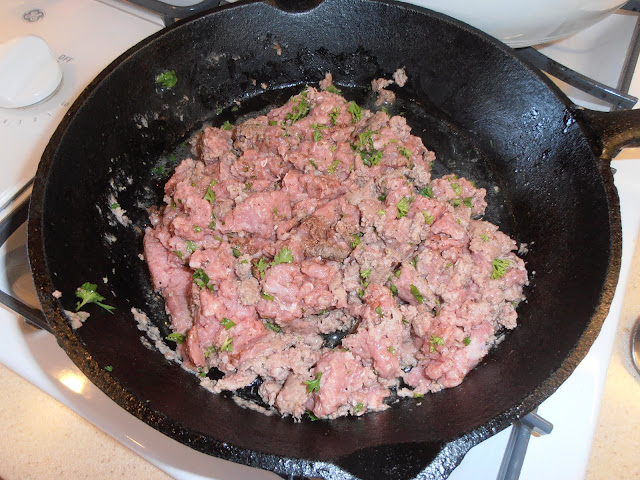Two eggplants were telling me they needed to be used. I kept thinking about a recipe I did a long time ago for this blog, Eggplant -- The Perfect Way. It is wonderful, with cheese and basil and spices. But I did not have the right cheese and definitely no basil -- the snails made short work of that in my garden and the seedlings are not big enough yet.
But I did have a packet of ground lamb in the freezer. Lamb and eggplant are a good pairing, and both together suggested a particular geographic location to consider for recipes.
 |
| ISBN 978-0-520-26174-7 |
I chose Recipe 44, on page 94.
Stuffed Eggplant
Ibn Razin, in one of seventeen recipes for stuffed eggplant, calls for extra stuffing to be spread over the eggplant before it is put in the oven.
Take some of our large eggplants. Remove the head [ris] of each eggplant and hollow out the inside in order to extract the pulp while taking care not to cut the skin; indeed, [the skin] should be of a good thickness. Then take some meat and pound it in a mortar and boil it. When it is cooked, pound it in the mortar [again] in order to make it still more tender. Put [it] in a pot [dast] and add fresh sheep tail fat, dry coriander [seeds], caraway, pepper, Chinese cinnamon, and fresh chopped coriander [cilantro] and parsley in great quantities. Fry all of it until it is roasted. Add salt and stuff the eggplant with this mixture. Close up [the stuffed eggplants] with what was cut off [i.e., the head]. Insert [in each eggplant] three sticks of good-quality wood that has been smoked [in order to reattach the head], then put them in the pot and cook over a lively fire in the sheep tail fat until they are well cooked. Then put them on a serving dish [zubdiyya] and sprinkle with dry coriander. At the moment of serving, remove the sticks and throw them away.

My Notes
I had no cilantro so I decided to use just parsley (from my garden!). Instead of sheep tail fat, I used olive oil.
I thought it interesting that there was no mention of "purging" the eggplant, after having read Perry's discussion of how eggplant was unpopular until it was discovered that salting it would remove the bitterness. I decided to follow the preparation directions in order -- that is, hollowing the eggplants before cooking the filling -- so I put the prepared eggplants into salted water while making the filling.
Honestly, I wasn't sure which end of the eggplant was the head. I decided it was the big end so it would be easy to hollow it and still leave thick walls.


I used a knife with a long, slender blade to roughly cut a circle into the length of the eggplant. This defined the thickness of the walls. Then I used a sturdy spoon to scoop out the flesh. Sometimes I poked the flesh a few times with the knife to make it easier to scoop.
Considering the meat I had was already ground, I decided I didn't need to pound it, boil it, and pound it again in order to make it tender.
The one pound of lamb was sauteed in olive oil and I added
1/4 teaspoon powdered coriander
1/4 teaspoon caraway seeds
1/2 teaspoon pepper
1/2 teaspoon cinnamon
1/4 cup chopped fresh parsley
 |
| Nearly done |
Stuffing the eggplant was easy. I just spooned the filling in, pushing it down to compact it after every few scoops. My goal was to stuff it to the brim and just a little past.
 |
| Stuff it! |
 |
| The picks were angled a little to help hold on the head. |
To serve them, I put them on a plate with the head next to it, after removing and throwing away the toothpicks. Then I sprinkled them with some powdered coriander.
The Verdict

I served them with a tossed green salad and some of the sorrel puree that had been thinned and flavored with beef bouillon.
The stuffing was great -- very flavorful and I think I got the spice balance just right. The eggplant was slightly undercooked in places, making it harder to cut than the well-cooked parts. But the combination of eggplant and filling was tasty!
The eggplant was a little bland by itself, which served as a good support for the filling. The combination was savory, spicy, creamy (the eggplant), slightly chewy (the filling). I noticed that the coriander sprinkled on top was warmed by the hot eggplant and provided a lovely, enticing, spicy scent when I sat down to eat.
Success!
The ends of the eggplant were not cooked well at all. I believe this is because they never touched the hot oil in the pan. The sides were all that were eaten.
The note in italics at the beginning of the recipe came to mind at this point. If I had baked the eggplants instead of frying them, I think they would have been thoroughly cooked, even at the ends. I would not have had the issue of needing to stop cooking when the head fell off, either.
If I did this again, I would try baking them. I might even spread more of the filling over the top before doing so!
I did have extra filling, which went well in a quesadilla for my lunch the next day.
No comments:
Post a Comment